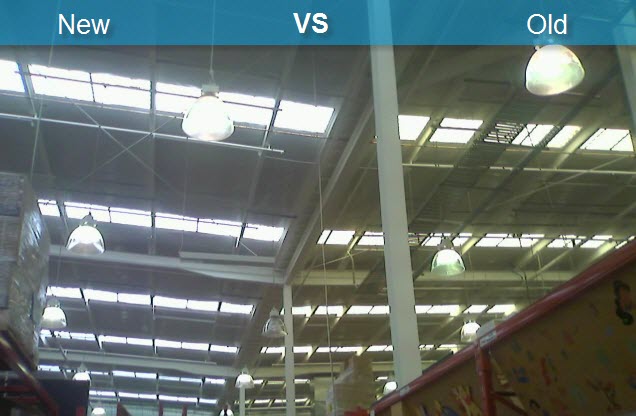Skylights
Commercial & Industrial Skylight Replacement
In any commercial or industrial building, skylights are an essential element. Not only do they provide a natural source of light but they can help reduce energy costs, assist with insulation and provide a healthier workplace. There are many benefits to having working natural lighting in the workplace, but the question most people ask is “how do I know if my skylights are working?”
Skylights not only create a natural source of lighting for your buildings but also offer health and power saving benefits. But many people don’t know how to tell if their skylights need replacing.



4 SIGNS YOUR SKYLIGHTS MAY NEED REPLACING
1. Building is over ten years old: Skylights come with varying life spans but generally need replacing after 10 years. If you think your building may be around this age it is worth getting them checked. 2. Skylights look yellow and discoloured: As skylights age they begin to show signs of wear and tear. As they change colour they loose efficiency. Yellow skylights will often only allow limited amounts of light through. 3. Light transmission is poor: As the name indicates the key purpose of a skylight is to allow light through, if your skylights are not allowing good levels of light in it may be time to replace these. 4. Leaking Skylights: While being designed to allow light in they are also still part of the roof structure and to that degree should be secure and water tight.WHY NATURAL LIGHT IS BETTER IN THE WORKPLACE
There is no denying that we humans are outdoor creatures, by and large. Even if some of us prefer a quiet beach to the mountainous wilderness, we would all still be happier outside than cooped up indoors out of the light of the sun. But, if this is true, shouldn’t we have as much natural sunlight as possible in our warehouse / office, where we spend so much of our time. Research suggests that indeed we should, with the benefits of natural light in the workplace far outweighing any benefits of artificial lights.
Lower Energy Consumption
It’s only logical that an increase in natural light lessens the need for any artificial light source, and that in turn means a fall in energy consumption. Admittedly, the reliance on electric lights is hardly going to end completely.You will like the fact that replacing your worn out, discoloured skylights will reduce your warehouses carbon footprint. After all, there is nothing running, nothing burning, and nothing wasted – just good, clean natural light from the sun.
Better Worker Health
According to research done in 1994, eyestrain, and the headaches and illnesses associated with it, is one of the biggest health problems in the workplace. This condition is related directly to the spectrum of light present in a workspace. When a workspace is poorly lit the eyes will be damaged, but eyestrain is significantly diminished when a window with a view is provided. This is because a landscape view provides a combination of both short-range and long-range views causing the eye to constantly refocus, which benefits the eyes. Natural light has also been linked with fewer headaches, increases in attentiveness, reductions in accidents and even better quality sleep when workers are at home.
Greater Positivity Leads to Greater Productivity.
Natural light has a hugely positive effect on people, promoting a sense of team work, higher levels of motivation and organisational attachment. Little surprise then that providing a bright, open and comfortable working environment is recognised as beneficial for everyone.
HOW TO DIAGNOSE A LEAKY DOME SKYLIGHT
Look to see if there is a water stain around the skylight unit or in the skylight tunnel. If the water stain is near the top of the skylight (the edge nearest the peak of your roof), there is a good chance the flashing on your roof around the skylight is failing. Water may be running down your roof and finding its way between the roofing and the skylight and into your home. Even if the flashing on your skylight is intact and working properly, if other pipes or vents above the skylight have compromised flashings, the water could be entering your roof there, then running down and leaking through your skylight opening.
If you do see signs of a leak at the top of your skylight, call a roofing professional to inspect the flashing on your roof. If you spot a water stain near the bottom of your skylight you may have more of a condensation issue than an actual leak. Condensation can form on the inside of your skylight when there is a lot of humidity in your house (which can be trapped by a skylight tunnel) or when it’s very cold outside. To keep condensated water from dripping, most skylights have a condensation channel surrounding the edges that captures it and allows it to evaporate. When too much condensation fills up the channel it can overflow and drip on the floor. If you discover a water stain at the bottom of your skylight and a roofing contractor has inspected your flashing, have him take a look at your condensation channel.
A skylight leak can cause minimal damage in the short term, but over time the damage can become significant. If you think the drips coming from your skylight are just condensation it is very important to be sure, as an actual leak can cause serious structural damage to your roof if left to prevail.
